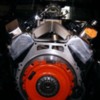OK I'm whining, but the truth is I need the softest clutch pedal I can get due to a degenerative disc in my back. I have a 72 Pantera and would like any and all advice to lighten up the pressure required when pushing down the clutch pedal. Thanks
Original Post


